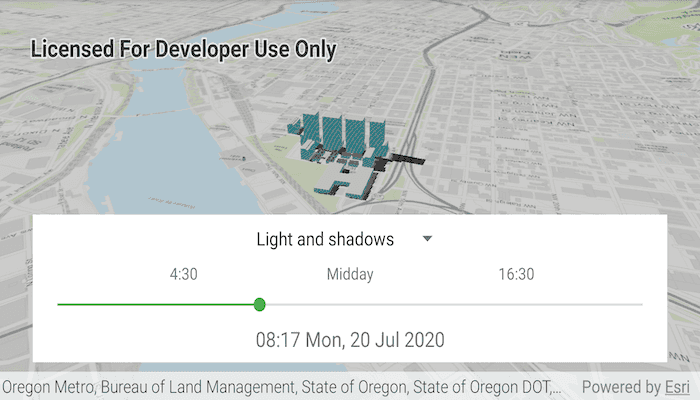Show realistic lighting and shadows for a given time of day.

Use case
You can use realistic lighting to evaluate the shadow impact of buildings and utility infrastructure on the surrounding community. This could be useful for civil engineers and urban planners, or for events management assessing the impact of building shadows during an outdoor event.
How to use the sample
Tap the floating action button to select lighting options. Select one of the three lighting options via the spinner to show that lighting effect on the SceneView. Select a time of day from the slider (based on a 24hr clock) to show the lighting for that time of day in the SceneView.
How it works
- Create an
ArcGISSceneand display it in aSceneView. - Create a
Calendarto define the time of day. - Set the sun time to that calendar with
sceneView.sunTime = calendar. - Set the lighting mode of the SceneView to
NO_LIGHT,LIGHT, orLIGHT_AND_SHADOWSwithsceneView.sunLighting = LightingMode.
Relevant API
- ArcGISScene
- LightingMode
- SceneView.sunLighting
- SceneView.sunTime
Tags
3D, lighting, realism, realistic, rendering, shadows, sun, time
Sample Code
/*
* Copyright 2020 Esri
*
* Licensed under the Apache License, Version 2.0 (the "License");
* you may not use this file except in compliance with the License.
* You may obtain a copy of the License at
*
* http://www.apache.org/licenses/LICENSE-2.0
*
* Unless required by applicable law or agreed to in writing, software
* distributed under the License is distributed on an "AS IS" BASIS,
* WITHOUT WARRANTIES OR CONDITIONS OF ANY KIND, either express or implied.
* See the License for the specific language governing permissions and
* limitations under the License.
*
*/
package com.esri.arcgisruntime.sample.realisticlightingandshadows
import android.os.Bundle
import android.view.MotionEvent
import android.view.View
import android.widget.*
import androidx.appcompat.app.AppCompatActivity
import androidx.coordinatorlayout.widget.CoordinatorLayout
import com.esri.arcgisruntime.ArcGISRuntimeEnvironment
import com.esri.arcgisruntime.layers.ArcGISSceneLayer
import com.esri.arcgisruntime.mapping.*
import com.esri.arcgisruntime.mapping.view.*
import com.esri.arcgisruntime.sample.realisticlightingandshadows.databinding.ActivityMainBinding
import com.google.android.material.floatingactionbutton.FloatingActionButton
import java.text.SimpleDateFormat
import java.util.*
import kotlin.math.floor
class MainActivity : AppCompatActivity() {
private val activityMainBinding by lazy {
ActivityMainBinding.inflate(layoutInflater)
}
private val sceneView: SceneView by lazy {
activityMainBinding.sceneView
}
private val dateTextView: TextView by lazy {
activityMainBinding.dateTextView
}
private val seekBar: SeekBar by lazy {
activityMainBinding.seekBar
}
private val spinner: Spinner by lazy {
activityMainBinding.spinner
}
private val fab: FloatingActionButton by lazy {
activityMainBinding.fab
}
override fun onCreate(savedInstanceState: Bundle?) {
super.onCreate(savedInstanceState)
setContentView(activityMainBinding.root)
// authentication with an API key or named user is required to access basemaps and other
// location services
ArcGISRuntimeEnvironment.setApiKey(BuildConfig.API_KEY)
// get the current calendar and set its time to midday
val calendar = Calendar.getInstance()
calendar.apply {
// set the time zone to the US West Coast, where this data is based
timeZone = TimeZone.getTimeZone("America/Los_Angeles")
set(Calendar.HOUR_OF_DAY, 12)
set(Calendar.MINUTE, 0)
}
val buildingsLayer =
ArcGISSceneLayer("https://tiles.arcgis.com/tiles/P3ePLMYs2RVChkJx/arcgis/rest/services/DevA_BuildingShells/SceneServer")
// create a scene with a vector basemap, a world elevation source, and a layer showing planned
// development in Portland, Oregon
sceneView.scene = ArcGISScene(BasemapStyle.ARCGIS_TOPOGRAPHIC).apply {
baseSurface =
Surface(listOf(ArcGISTiledElevationSource("https://elevation3d.arcgis.com/arcgis/rest/services/WorldElevation3D/Terrain3D/ImageServer")))
operationalLayers.add(buildingsLayer)
}
// initialize the scene with a realistic atmosphere and a set its time to the calendar
sceneView.apply {
setViewpointCamera(
Camera(
45.54605,
-122.69033,
941.00021,
162.58544,
60.0,
0.0
)
)
atmosphereEffect = AtmosphereEffect.REALISTIC
sunTime = calendar
}
val dateFormat = SimpleDateFormat("HH:mm EEE, dd MMM yyyy", Locale.US).apply {
timeZone = TimeZone.getTimeZone("America/Los_Angeles")
}
// display the full date and time in a text view
dateTextView.text = dateFormat.format(calendar.time)
// change the time of day with the seekbar
seekBar.setOnSeekBarChangeListener(object : SeekBar.OnSeekBarChangeListener {
override fun onProgressChanged(seekBar: SeekBar?, progress: Int, fromUser: Boolean) {
// slider progress represents minutes in the day (0-1439)
val hours = floor((progress / 60.0)).toInt()
val minutes = progress % 60
calendar.apply {
set(Calendar.HOUR_OF_DAY, hours)
set(Calendar.MINUTE, minutes)
}
// display the full date and time in a text view()
dateTextView.text = dateFormat.format(calendar.time)
// set the sun time on the scene to the modified calendar
sceneView.sunTime = calendar
}
override fun onStartTrackingTouch(seekBar: SeekBar?) {}
override fun onStopTrackingTouch(seekBar: SeekBar?) {}
})
// create a spinner adapter to select lighting modes
ArrayAdapter.createFromResource(
this,
R.array.lighting_modes,
android.R.layout.simple_spinner_item
).also { adapter ->
adapter.setDropDownViewResource(android.R.layout.simple_spinner_dropdown_item)
spinner.adapter = adapter
}
// change the lighting mode when a spinner item is selected
spinner.onItemSelectedListener = object : AdapterView.OnItemSelectedListener,
AdapterView.OnItemClickListener {
override fun onItemSelected(
parent: AdapterView<*>,
view: View?,
position: Int,
id: Long
) {
val mode = parent.getItemAtPosition(position) as String
sceneView.sunLighting = when (mode) {
"No light" -> LightingMode.NO_LIGHT
"Light only" -> LightingMode.LIGHT
"Light and shadows" -> LightingMode.LIGHT_AND_SHADOWS
else -> LightingMode.LIGHT_AND_SHADOWS
}
}
override fun onNothingSelected(parent: AdapterView<*>?) {}
override fun onItemClick(
parent: AdapterView<*>?,
view: View?,
position: Int,
id: Long
) {
}
}
// select "light and shadows" option by default
spinner.setSelection(2)
sceneView.apply {
// make sure the fab doesn't obscure the attribution bar
addAttributionViewLayoutChangeListener { _, _, _, _, bottom, _, _, _, oldBottom ->
val layoutParams = fab.layoutParams as CoordinatorLayout.LayoutParams
layoutParams.bottomMargin += bottom - oldBottom
}
// close the options when the scene is tapped
setOnTouchListener(object : DefaultSceneViewOnTouchListener(sceneView) {
override fun onTouch(view: View?, motionEvent: MotionEvent?): Boolean {
if (view == sceneView) {
if (fab.isExpanded) {
fab.isExpanded = false
}
}
return super.onTouch(view, motionEvent)
}
})
}
// open and close the options with the fab
fab.setOnClickListener { fab.isExpanded = !fab.isExpanded }
}
override fun onResume() {
super.onResume()
sceneView.resume()
}
override fun onPause() {
sceneView.pause()
super.onPause()
}
override fun onDestroy() {
sceneView.dispose()
super.onDestroy()
}
}